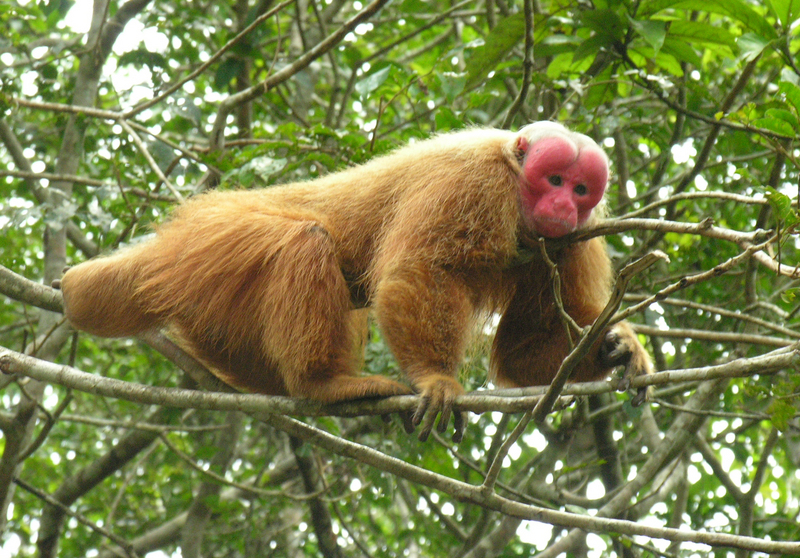Uakari (Genus: Cacajao) - Wiki Uakari
From Wikipedia, the free encyclopedia
Order: Primates
Family: Pitheciidae
Subfamily: Pitheciinae
Genus: Cacajao Lesson, 1840
Type species: Simia melanocephalus Humboldt, 1812
Species
- Cacajao melanocephalus
- Cacajao calvus
- Cacajao ayresii
[Photo] Bald Uakari (Cacajao calvus) male. Photo by Evgenia Kononova. 17 January 2006 (Taruma River, Brazil). Public domain by its author, Evgenia Kononova.
Uakari is the common name for the New World monkeys of the genus Cacajao. The common name is believed to come from the indigenous term for "Dutchmen"; their red faces apparently reminded the locals of sun-burned Europeans. Cacajao is also believed to be an indigenous name, of unknown meaning now, as the tribe and language is extinct.
The uakaris are unusual among New World monkeys in that the tail length (15-18 cm) is substantially less than their head and body length (40-45 cm). Their bodies are covered with long, loose hair but their heads are bald. They have almost no subcutaneous fat, so their bald faces appear almost skull like. Like their closest relatives the saki monkeys, they have projecting lower incisors.
The three species of uakari currently recognised are both found in the upper Amazon Basin. The Black-headed Uakari is found north of the river, between the River Branco and the River Japurá. The Bald Uakari is found south of the Amazon, on the other side of the Japurá.
Uakaris are typically lethargic and silent in zoo conditions, but in the wild they are agile and active, capable of leaps of over 6 metres. They have been observed both in small groups and in larger troops of up to 100. When travelling through the forest they move in the lower branches of the trees, though when foraging they also go up to the canopy. They eat fruit, nuts, buds and leaves.
Henry Walter Bates, the nineteenth century zoologist, recorded that the Native Americans captured uakaris alive by using blowpipe darts or arrows tipped with diluted curare; once captured the animals were revived by putting a pinch of salt in their mouths. Those animals that survived were kept as pets.
Species
There are three species in this genus:
Genus Cacajao
Black-headed Uakari, Cacajao melanocephalus
- Cacajao melanocephalus melanocephalus
- Cacajao melanocephalus ouakary
Bald Uakari or Red Uakari, C. calvus
- Cacajao calvus calvus
- Cacajao calvus ucayalii
- Cacajao calvus rubicundus
- Cacajao calvus novaesi
Ayres Uakari, Cacajao ayresii (Newly identified species)
http://en.wikipedia.org/wiki/Uakari
| The text in this page is based on the copyrighted Wikipedia article shown in above URL. It is used under the GNU Free Documentation License. You may redistribute it, verbatim or modified, providing that you comply with the terms of the GFDL. |
